
94% of researchers rate our articles as excellent or good
Learn more about the work of our research integrity team to safeguard the quality of each article we publish.
Find out more
ORIGINAL RESEARCH article
Front. Vet. Sci., 06 September 2021
Sec. Animal Behavior and Welfare
Volume 8 - 2021 | https://doi.org/10.3389/fvets.2021.735680
 Hao-Yu Shih1*
Hao-Yu Shih1* Clive J. C. Phillips2
Clive J. C. Phillips2 Daniel S. Mills3
Daniel S. Mills3 Yifei Yang1
Yifei Yang1 Fillipe Georgiou4
Fillipe Georgiou4 Mandy B. A. Paterson1,5
Mandy B. A. Paterson1,5Leash pulling is a concern for dog owners and can be detrimental to the health and welfare of dogs. Neck-collars and back-connection harnesses are popular restraint types. Harnesses have been proposed as a better and more considerate option for canine health and welfare. Anecdotally, dogs pull more when wearing a back-connection harness; however, there is no scientific evidence for this perception. This study aimed to investigate how strongly dogs pull on the lead to achieve a food treat or toy under restraint by a neck-collar versus a back-connection harness. A within-subject counterbalanced design was used for the study, involving 52 shelter dogs. A customised canine leash tension metre was connected to the collar or harness to record the pulling of the dogs, including measuring the maximal and mean leash tension, and the time spent pulling. In addition, dog behaviours were recorded using two cameras from two separate directions. The maximal and mean leash tension and the pulling time were greater under restraint by harness when attracting dogs with food treats. No significant difference between harness and collar was found in potential stress-related behaviours (e.g. tail and ear positions, lip-licking, and panting). However, dogs looked at the experimenter more often when restrained by harness than collar in the food treat attraction test. No significant difference was detected between harness and collar with respect to leash tension and stress-related behaviours in the toy attraction test. These findings suggest that dogs tend to pull stronger and more steadily when wearing a back-connection harness compared to a neck collar to reach the food treat but not the toy.
Compulsory leash policies, requiring dogs to be kept on-leash in public areas (1–3) have been implemented in many countries in order to protect wildlife (4), reduce disease transmission (5), and prevent dog attacks and involvement in traffic accidents (6, 7). Despite increasing emphasis on loose leash heelwork, many dogs still lunge and/or consistently pull on the leash during walks, especially when encountering stimuli of interest to them, such as food scraps or another dog (8). A survey with U.K. and Irish owners of pet dogs found that 82.7% of dogs pulled while on the lead (9). Pulling on the leash is also one of the most common problems reported in shelter dogs during the first month post-adoption (10).
Researchers have investigated the controlling effects and potential welfare concerns of different restraint types. For dogs wearing collars, excess pressure on the neck may cause musculoskeletal and tracheal injuries, and/or have negative effects on their eyes (11). Ogburn et al. (12) found that, compared to head collars, dogs were more disobedient on the leash while wearing traditional neck collars, although no significant differences in physiological responses, including blood pressure, pulse rate, respiratory rate, pupil diameter, and plasma cortisol concentrations, were detected. Nonetheless, dogs more frequently pawed at their noses and lowered their heads and ears when wearing the headcollar (12). Studies regarding the effect of harnesses on canine walking patterns are inconclusive. Lafuente et al. (13) found that harnesses influenced canine gait during walking and trotting by restricting their shoulder extension. Nagymáté et al. (14), however, reported that harnesses did not affect the dog's walking kinematics when they were walking off-leash or with a tense leash, and Grainger et al. (15) reported no difference in the gait and stress related signs when dogs walked or trotted in a harness vs. a plain neck collar.
There is a variety of equipment that owners use to walk their dogs, with flat-collars and back-connection harnesses being the most popular equipment choices (9). Harnesses may be a better restraint method, as the force exerted when wearing a harness is distributed over a larger area, while the force exerted on the neck when wearing a neck collar is more localised, increasing the potential for injury, or the exacerbation of existing medical conditions (16).
Despite plentiful literature concerning the potential animal welfare concerns stemming from different restraint methods, there is limited research of the effect of restraints on canine pulling behaviours. Anecdotally, back-connection harnesses are believed to relate to increased canine pulling on the leash [e.g., (17)]. This study examines this empirical hypothesis by investigating how strongly and for how long dogs pull on the leash to reach something they want while under restraint by a neck-collar vs. a back-connection harness. It was hypothesised that dogs would pull more strongly and for longer when the leash was connected to a harness compared to a neck collar, in line with common anecdotal opinion.
This study was approved by the Animal Ethics Committee (Approval number: SVS/400/18) of The University of Queensland.
The research was conducted at the Royal Society for the Prevention of Cruelty to Animals, Queensland (RSPCA, QLD) shelter. Dogs were housed individually in rows of adjacent kennels (1.8 m wide × 1.2 m long × 3.0 m high) indoors and were able to make visual but not physical contact with one another across the central passage. Every enclosure was furnished with a metal crate, a raised mattress, a water bowl and enrichment articles (e.g., rubber toys or cardboard boxes). Each dog was walked twice daily, once in the morning between 08:00 and 10:00 h, and once in the afternoon between 14:00 and 16:00 h.
This study involved 52 shelter dogs. All participating dogs had been resident at the RSPCA, QLD, for at least 1 week. The 52 subjects were 23 males and 29 females, ranging in age from 13 months to 11 years, and all dogs were gonadectomised. The body weight of the dogs ranged from 16 to 43 kg [median = 24 kg, interquartile range (IQR) = 7.76 kg]. All shelter dogs wore both the neck collar (plain neck collars of different brands) and the chest harness (Balance harness, Black Dog Wear Pty Ltd, Victoria, Australia) (Figure 1), and the leash was attached to both the collar and the harness in front of the chest of the dog (Figures 1A,C), during their daily walks (18), with a view to providing better control over the dog should they lunge (19). Therefore, all participant dogs were used to both restraint types and wore both restraints at all times during the study. Dogs with behavioural or medical issues (e.g., overtly aggressive or timid; suspected neck problems), as assessed by the RSPCA's behavioural modification team and veterinarians, that were deemed to be unsuitable for research were excluded from the study. Subjects were otherwise randomly selected from the adoption pens. Since each candidate dog lived individually in a pen with a pen number, a random number generator app (20) was used to randomly determine the participant dogs.
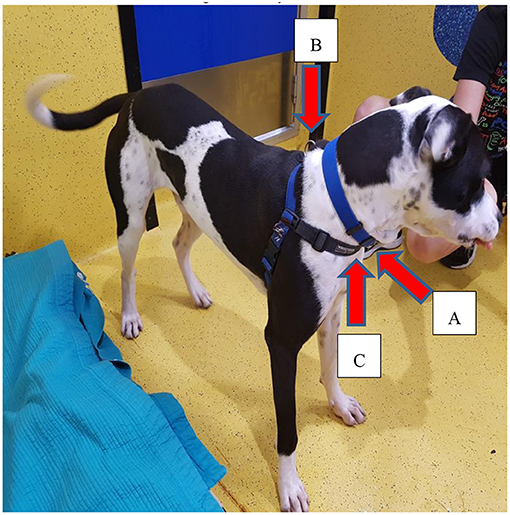
Figure 1. Dogs at RSPCA QLD wore both the collar and harness both during their daily walking routine and throughout the entire duration of the study. In this study, the leash tension metre (RobacScience, New South Wales, Australia) was connected to the collar (A) and harness (B) to test the pulling of dogs with both restraint types. The harness has one more front-attaching ring at the chest level (C) which is not shown in this picture.
Each dog had an assigned walking level: levels 1, 2, 3, and 3+. These levels are assigned by RSPCA QLD staff based on their ease of walking on the leash during their daily walk. Level 1 dogs were those that walked on a loose leash most of the time. Level 2 was assigned to dogs pulling on the leash during the walk occasionally and displaying more undesirable behaviours than level 1 dogs. Level 3 was assigned to dogs which tended to pull on the leash fiercely and often, due to excitement or timidity. Level 3+ was reserved for dogs having severe behavioural issues, such as overt excitement or fearfulness, but which could still be managed by experienced volunteers; however, they were not assessed to necessarily pull on the leash with greater force than level 3 dogs. RSPCA QLD walking levels were ascribed as follows: one level 1, twenty-six level 2, twenty-one level 3, and four level 3+ dogs.
A within-subject counterbalanced design was used in this study, with each individual dog acting as its own matched control. Participating dogs were taken to an air-conditioned experimental room away from distractions (e.g., other people and dogs), and were given 10 min to become accustomed to the environment. On one side of the room, at the starting point, a tie-up ring was secured on the wall (Figure 2A). The leash tension metre (RobacScience, New South Wales, Australia) (18) was connected to the tie-up ring using two carabiners (Anko, Australia) (Figure 3A). On the other end of the device was a stainless-steel eyebolt to allow a simple connection with a l.4-m-long commercial dog leash (Rogz Snake Lead) (Figure 3B) (18). This leash was then connected to the dog (Figure 3C), allowing the dog an ~1.4-metre maximal movement distance (Figure 2C). A camera (GoPro Hero 7 Silver, GoPro®, San Mateo, CA, USA) and an i-Phone 7 (Apple Inc., Cupertino, CA, USA) were set next to the tie-up ring on a cabinet (Figure 2B) and on the other side of the room (Figure 2F), respectively, to record the behaviours of the dog.
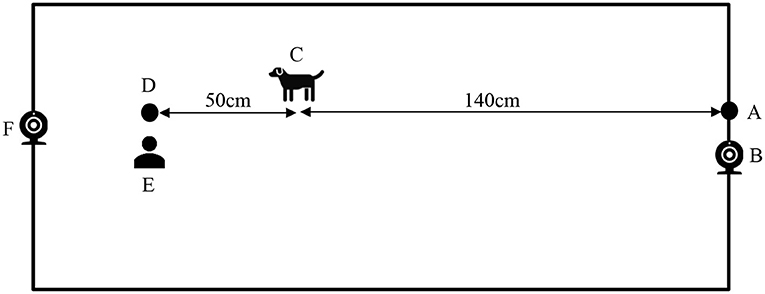
Figure 2. Illustration of the study area. The leash tension metre along with a l.4-metre-long dog leash was connected to the fixed point (A), giving the dog an approximately 1.4-m maximal movement distance (C). The attractant was placed on the floor 50 cm forward of the 1.4-metre maximal movement distance (D) and the experimenter knelt next to the attractant (E). One camera was set next to the fixed point (B) and the other was set on the other side of the room (F).
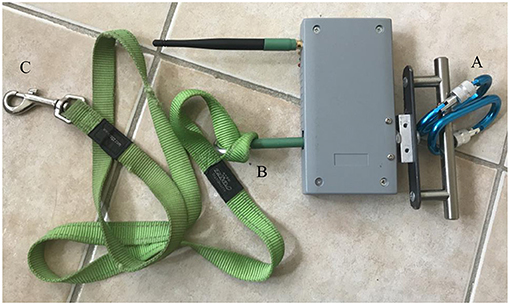
Figure 3. Demonstration of the leash tension metre. One end of the leash tension metre was connected to the tie-up ring using two carabiners (A). On the other end of the device was a stainless-steel eyebolt to allow a simple connexion with a l.4-m-long commercial dog leash (B), and the leash would be connected to the dog (C).
Before each trial, the leash was left unconnected to the dog for 10 s and the signals generated were used to calibrate the recorded data using MATLAB® (MATLAB® and Statistics Toolbox Release 2018b, The MathWorks, Inc., Natick, MA, USA). The experimenter then pulled the two ends of the tension metre and held the pull for 3 s by counting slowly “1, 2, 3.” This procedure was repeated three times in order to synchronise the tension data with the video. The leash was then connected to the collar (Figure 1A) or harness (Figure 1B) [randomly determined (21)] of the dog. The experimenter attracted the attention of the dog with a treat (Canine Care Australia, WA, Australia), slowly walking away and placing the treat on the ground 50 cm in front of the dog when the leash reached its full length (Figure 2D). Meanwhile, the experimenter knelt (Figure 2E) and faced away from the dog to avoid any cues that might influence the behaviour of the dog. Ten seconds after the treat was placed on the ground, the experimenter picked up the treat and guided the dog back to the starting point. The dog then took a 10 min break. After the break, the experimenter reconnected the leash to the neck collar or chest harness (whichever had not been connected the first time) and repeated the procedure again by attracting the dog with the treat. At the end of the food attraction test, the dog was rewarded with the treat and again given a 10 min break. After the second break, the experimenter reconnected the leash to either the neck collar or the chest harness [once more randomly determined (20)] and repeated the above two procedures, except this time attracting the dog with a toy; a squeaky tennis ball (KONG®, CO, USA). Four dogs were tested each day and the order of testing the dogs throughout the day was randomly determined (20).
Two-hundred-and-six (food treat trials: n = 104; toy trials: n = 102) videos were coded in their entirety with Boris behaviour observation software (22) using a continuous recording method. One dog showed fear responses to the toy and thus the experimenter did not test it with the toy. All videos were coded by an independent observer who was unaware of the research hypothesis being tested. Coded behaviours were potential stress related signals, including tail and body positions, panting, and lip-licking as shown in Table 1.
Maximal and mean leash tension and the pulling time initiated by the dog were recorded by the leash tension metre. The pulling time was defined as the time dogs pulled on the leash with force greater than the threshold. Given the potential tissue damage to dogs when the leash tension was kept around 1% of body-weight-force, a threshold was set as 1% of body weight (32). Recorded data were processed using MATLAB® (MATLAB® and Statistics Toolbox Release 2018b, The MathWorks, Inc., Natick, MA, USA). For more details regarding the leash tension metre, please refer to Shih et al., (18).
Given the within-subject counterbalanced design, a Wilcoxon signed-rank test was initially used to evaluate our primary hypotheses concerning the difference between the harness and collar in terms of leash tension, pulling time, and behaviours expressed. This was followed by a multivariate analysis, to examine the main sources of variation contributing to the differences observed. Linear mixed-effects models followed by the backward elimination process were used for analyses. Where maximal and mean leash tension and the pulling time were considered as outcome variables, restraint types (collar/harness), the order of restraint type used, the order of each dog participating in the study during the day, and RSPCA canine walking level were entered into the models as predictors, and the ID of the dogs was set as a random effect. Normality of residual and the random effect were analysed using a normality plot and Shapiro–Wilk test and homogeneity of variance of residuals (VIF < 2). In line with the recommendations of Perneger, given the relative importance of type 1 vs. type 2 statistical errors on our exploration of potential factors of importance, no statistical correction for multiple testing was made (33).
Overall, the median maximal and mean leash tension were 0.62 kg-force/6.08 N (IQR = 2.56 kg-force/25.11 N) and 0.28 kg-force/2.75N (IQR = 0.39 kg-force/3.83N) respectively and the median proportion of pulling time was 0.23 (IQR = 0.86).
In the bivariate analyses, when testing dogs with food treats, the median maximal (p = 0.05) and mean (p = 0.0099) leash tension and the proportion of pulling time (p = 0.031) were significantly higher in the harness trial condition (maximal = 1.72 kg-force/16.87N; mean = 0.54 kg-force/5.3N; proportion of pulling time = 0.67) compared to the collar (maximal = 0.71 kg-force/6.97N; mean = 0.32 kg-force/3.14N; proportion of pulling time = 0.35) (Table 2). The proportion of pulling time is defined as the proportion of time dogs pulled on the leash with the force >1% of body weight. The threshold was set as 1% of body weight due to the potential tissue damage to dogs when the leash tension was kept around 1% of body-weight-force (32).
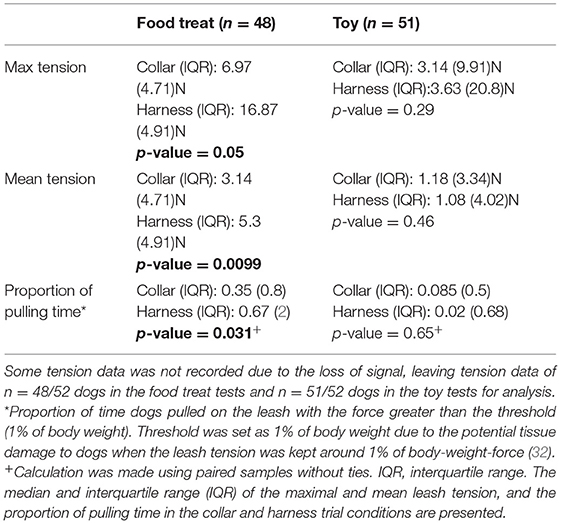
Table 2. Bivariate analysis (Wilcoxon signed-rank test) of leash tension between neck collar and chest harness conditions.
In the mixed-effect models, compared to the collar condition, the maximal (p = 0.0085) and mean (p = 0.0067) leash tension and the proportion of pulling time (p = 0.028) were significantly higher in the harness condition during the food treat session (Table 3). In both food treat and toy sessions, the maximal (food treat: p = 0.019; toy: p = 0.0062) and mean (food treat: p = 0.022; toy: p = 0.017) leash tension and the proportion of pulling time (food treat: p = 0.011; toy: p = 0.017) significantly decreased in the second trial (Table 3).
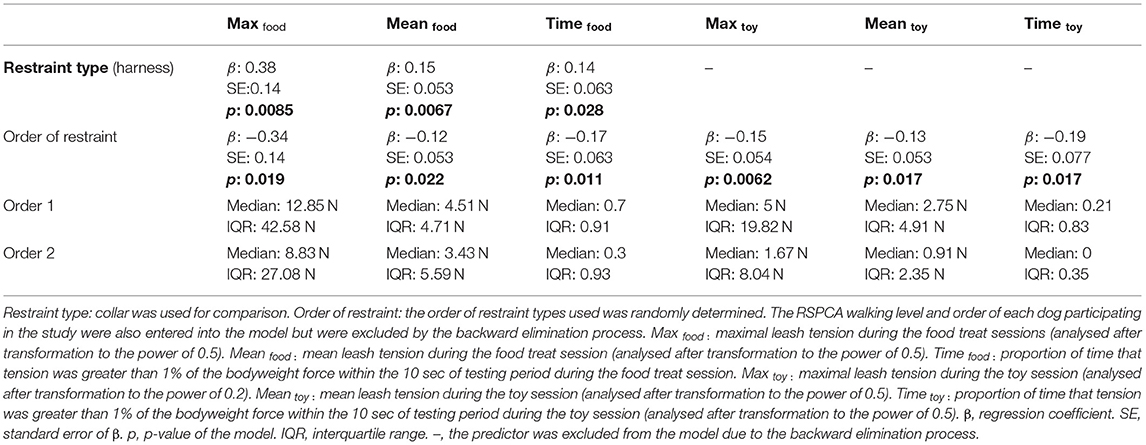
Table 3. Linear mixed-effects model of the effects of restraint types and the order of restraint types used on leash tension and pulling time.
Paw-lifting, body shaking, sniffing, and vocalisation were seldom observed (Appendix Table 1); therefore these behaviours were excluded from analysis. Dogs looked at the experimenter significantly more frequently in the harness condition when tested with food treats (Wilcoxon signed-rank test: p = 0.011; mixed-effect model: p = 0.039) (Tables 4, 5).
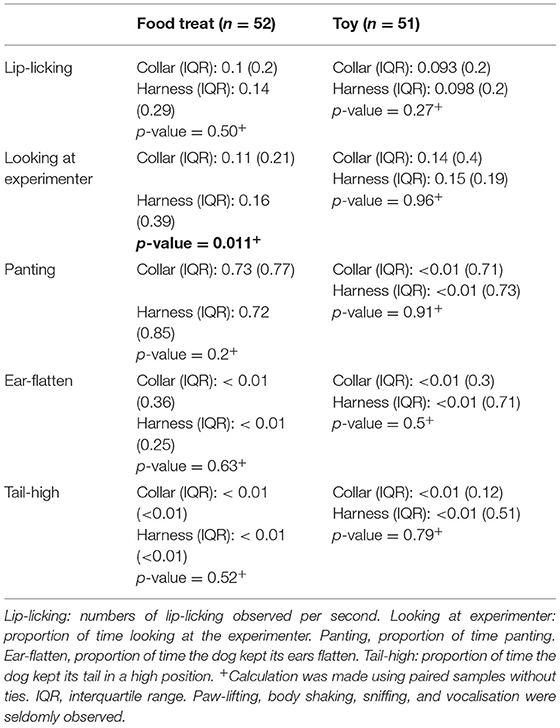
Table 4. Bivariate analysis (Wilcoxon signed-rank test) of behaviours expressed in neck collar and chest harness conditions.
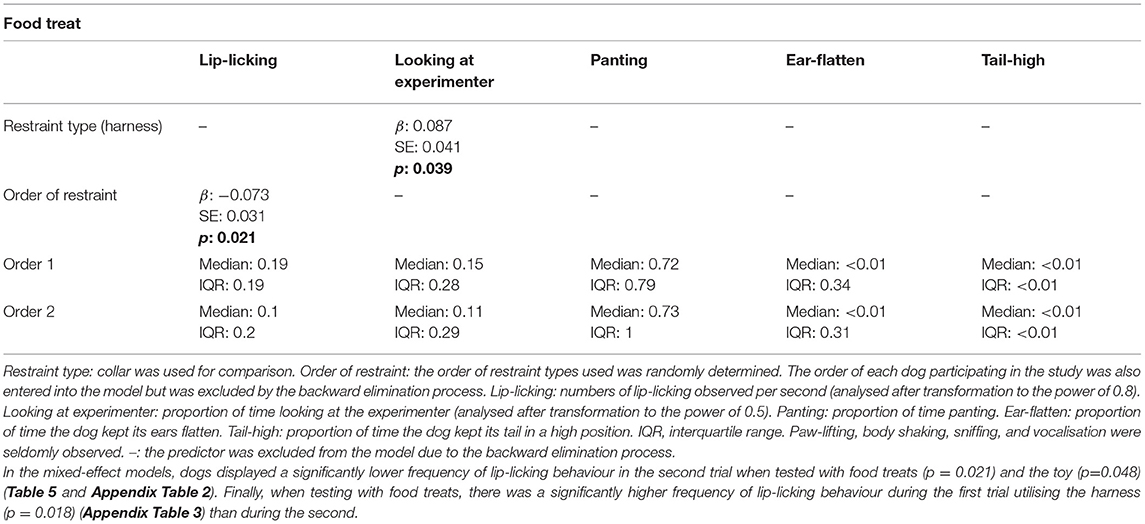
Table 5. Linear mixed-effects model of the effects of restraint types and the order of restraint types used on canine behaviours when testing with food treats.
Our study supports the hypothesis that back-connection harnesses are associated with greater pulling on the leash. This finding is in line with the suggestion that dogs may be more comfortable when they wear a harness than a neck collar because the former enables the force exerted on the body to be more dispersed while the later causes localised pressure on the neck leading to increased discomfort (16).
When dogs were attracted with food treats, but not the toy, they created significantly higher leash tension and spent more time pulling when the leash was connected to the back-connection harness than to the neck collar. It may be that the toy was less appealing than food treats for many dogs, and/or dogs were generally less reactive to a toy when on-leash, since generally dogs do not play with a squeaky tennis ball when on-leash. It is also possible that the squeaky toy may be perceived as a foreign object that could potentially elicit more careful behaviour or even fear in shelter dogs as also seen in one of the participating dogs. Finally, there was an order effect since the toy test was done after the food treat test (12). It might be that dogs were habituated to the research process and thus were less responsive in the later toy tests.
In line with the previous study (15), we found no significant differences with respect to potential stress-related behaviours (e.g., lip-licking, panting, ears and tail position) between the collar and the harness. However, in the current study, dogs were tested in only a mildly to moderately excited state. Thus, we do not dismiss the concern with respect to the potential for tissue damage and health concerns resulting from the compression of the neck from a neck collar, especially when dogs are highly aroused (11, 34). Under the harness condition, dogs spent more time looking at the experimenter when tested with food treats and this might relate to differences in how the restraints are perceived. If the harness was more comfortable, their response may not be punished by the pulling, and so they may be less likely to stop the behaviour. Accordingly, they may be more likely to consider alternative solutions to the problem of accessing the resource, which may involve seeking assistance from humans through referential looking (35, 36). The other possible explanation may be that the localised force on the neck because of wearing a neck collar may restrict the head movement of dogs, causing them to be less likely to turn their heads to look at the experimenter. Also, dogs shift their weight depending on which side of their body the leash is on, and there may be a similar influence on the neck of the dog (37). However, in this study authors did not compare the effect of the harness vs. the neck collar and the effect of leash position on the range of motion and movement symmetry of the head or other body parts of the dog. Finally, given that a similar result was not observed when dogs were lured by the toy, and the force exerted by dogs was not as great, this might indicate that dogs did not value the toy as much as the food treat or could reflect carry-over effects from the first trial.
Dogs displayed fewer lip-licking behaviours in the second trial, again, possibly because they were more accustomed to the research procedure. Specifically, the frequency of lip-licking was higher during the first trial of the harness condition. It may be that the lip-licking in this context is not so much a sign of frustration (38), but actually a response to the appearance of the food treat and the lower deterrent effect of the harness; that is, an anticipatory response to the potential opportunity for food consumption (38). This would explain why other potential behavioural markers of distress did not increase as well.
The primary factor of interest was the role of restraint type (neck collar and back-connection harness) as a predictor of leash tension and behaviour regardless of the variation caused by other factors, which is why the data were analysed first using a simple bivariate analysis. Having established this, it is useful to evaluate the potential influence of other factors (39) such as the order of application of the restraint types used, the order of each dog's participation in the study during the day, and the dog's level of control when walking on-leash. Therefore, these factors were included in multivariable models for further analysis. This revealed that the order of use of the restraint type was significant and thus the importance of controlling for this in the current study and future investigations.
Pressure sensors embedded in collars and harnesses have been utilised to assess the potential welfare and health impact of different restraint types on dogs. Such instruments measure the pressure experienced by the dog and the distribution of the pressure on the body of the dog (32, 40). However, the dog's experience may also be affected by that of the handler, who may jerk the leash, according to the tension they feel the dog is exerting (9, 41, 42). A leash tension metre, such as that used in this study, not only measures the tension of the leash but also differentiates the pulling direction, allowing us to quantify the pulling forces initiated by the dog and the handler respectively (18). Being pulled over by dogs is the most common form of dog-related musculoskeletal injury in persons in the U.K. (43), and frequent, long-term leash pulling may predispose handlers to upper limb injury such as shoulder pain, and hand sprain and strain (44). With a leash tension metre, it is possible to identify whether transient peak force or continuous pulling by a dog is more important to the experience of walking the dog and the risk of relevant injuries to either handler or dog. Another useful application of this device would be to explore the effects of other restraint types (e.g., different textures or widths of collar and different designs of collar and harness, especially those designed to reduce pulling) on canine leash pulling behaviour and owner response as a result.
In terms of our leash tension metre, the strain gauge (force sensor) and the accelerometer (direction sensor) used in this study were built into a box and held by the handler. Touching the leash with the other hand (the ideal way of walking dogs) would interfere with the measurement. Therefore, this device is designed for handlers to walk the dog using one hand only (18), and while walking dogs with a single hand is still very common for dog owners, it is not the most secure way to walk a dog. Alternatively, the sensors can be attached to the dog end of the leash, so that walking dogs with both hands to maximise control (especially with dogs who surge when on lead) would not affect the results. Dogs with this problem would be a useful population to study further. Nonetheless, even well-behaved dogs may occasionally surge towards a focus of interest and this study deliberately did not involve pulling initiated by the handler and is the first study to quantify the effect of restraint types on leash tension.
Limitations include the use of only shelter dogs; therefore, broad generalisations of the specific results should be made with caution. However, this population allowed us to work with a population that has experience of both forms of restraint, and is a strength of this study, since neither device on the dog was novel. However, we acknowledge that the history of restraint types used for each dog was unknown. Nonetheless these factors do not detract from the fact that this is the first study to quantify the leash pulling by dogs wearing collars and harnesses. Another limitation is that dogs seemed to be less responsive to the toy than the food treat, which was at the same time confounded by the testing order (dogs were always presented with food treat then toy). Future studies should consider randomising the testing object or confirm the interest of the dog to the object before testing. Finally, future studies might build on this by examining the effects of breed on the results, since some dog breeds have been specifically bred to pull objects (e.g., Alaskan malamutes and Siberian huskies), and may be more resistant to the pressure resulting from leash pulling (11).
Dogs pulled harder and more steadily on the leash to reach food, but not toys when the leash was connected to the back-connection harness compared to the neck collar. Although increased pulling behaviour was related to the back-connection harness, this was not accompanied by a significant increase in potential stress-related responses.
The raw data supporting the conclusions of this article will be made available by the authors, without undue reservation.
The animal study was reviewed and approved by Animal Ethics Committees (Approval number: SVS/400/18) of The University of Queensland.
H-YS, CP, DM, and MP: conceptualisation. H-YS, CP, DM, FG, and MP: methodology. FG, H-YS, and YY: software. H-YS: writing—original draft preparation and investigation. H-YS, YY, FG, and CP: validation, formal analysis, and data curation. MP and CP: resources. H-YS, DM, CP, MP, YY, and FG: writing—review and editing. H-YS and CP: visualisation and funding acquisition. MP, CP, and DM: supervision. H-YS and MP: project administration. All authors contributed to the article and approved the submitted version.
This research was funded by the Higher Degree Research Fund of the University of Queensland and the RSPCA Fund donated by philanthropists.
MP is employed as the principal scientist by RSPCA, Qld.
The remaining authors declare that the research was conducted in the absence of any commercial or financial relationships that could be construed as a potential conflict of interest.
All claims expressed in this article are solely those of the authors and do not necessarily represent those of their affiliated organizations, or those of the publisher, the editors and the reviewers. Any product that may be evaluated in this article, or claim that may be made by its manufacturer, is not guaranteed or endorsed by the publisher.
We thank RSPCA, QLD for allowing us to conduct this research at the shelter. We also appreciate all dogs and RSPCA staff for playing important roles in this study. Finally, we acknowledge Dr. Solomon Woldeyohannes for statistical advice.
The Supplementary Material for this article can be found online at: https://www.frontiersin.org/articles/10.3389/fvets.2021.735680/full#supplementary-material
1. Government of the United Kingdom. Controlling your dog in public. Available online at: https://www.gov.uk/control-dog-public/public-spaces-protection-orders (accessed April 5, 2021).
2. Michigan Legislative Council. (1970). 287.262 Dogs; licensing, tags, leashes. Available online at: http://legislature.mi.gov/doc.aspx?mcl-287-262 (accessed April 5, 2021).
3. Brisbane City Council. (2019). Keeping a dog. Available online at: https://www.brisbane.qld.gov.au/community-and-safety/pets/looking-after-your-pet/keeping-a-dog (accessed September 18, 2020).
4. Bowes M, Keller P, Rollins R, Gifford R. The effect of ambivalence on onleash dog walking compliance behavior in parks and protected areas. J Park Recreation Adm. (2017) 35:81–93. doi: 10.18666/JPRA-2017-V35-I3-7440
5. Day MJ, Breitschwerdt E, Cleaveland S, Karkare U, Khanna C, Kirpensteijn J, et al. Surveillance of zoonotic infectious disease transmitted by small companion animals. Emerg Infect Dis. (2012) 18:e1. doi: 10.3201/eid1812.120664
6. Klainbart S, Bibring U, Strich D, Chai O, Bdolah-Abram T, Aroch I, et al. Retrospective evaluation of 140 dogs involved in road traffic accidents. Vet Rec. (2018) 182:196. doi: 10.1136/vr.104293
7. Jakeman M, Oxley JA, Owczarczak-Garstecka SC, Westgarth C. Pet dog bites in children: management and prevention. BMJ Paediatr Open. (2020) 4:e000726. doi: 10.1136/bmjpo-2020-000726
8. Walthers C, Faulkner L, Martin A. Social contact in shelter dogs: literature review and recommendations. Psychology Undergraduate Scholarly Works, Kennesaw State University, Georgia (2019).
9. Townsend L, Dixon L, Chase – Topping M, Buckley L. Owner approaches and attitudes to the problem of lead-pulling behaviour in pet-dogs. In: Behaviour—A Multidisciplinary Approach. BVBA Study Day (2021).
10. Marston LC, Bennett PC, Coleman GJ. Adopting shelter dogs: Owner experiences of the first month post-adoption. Anthrozoös. (2005) 18:358–78. doi: 10.2752/089279305785593965
11. Pauli AM, Bentley E, Diehl KA, Miller PE. Effects of the application of neck pressure by a collar or harness on intraocular pressure in dogs. J Am Anim Hosp Assoc. (2006) 42:207–11. doi: 10.5326/0420207
12. Ogburn P, Crouse S, Martin F, Houpt K. Comparison of behavioral and physiological responses of dogs wearing two different types of collars. Appl Anim Behav Sci. (1998) 61:133–42. doi: 10.1016/S0168-1591(98)00113-0
13. Lafuente MP, Provis L, Schmalz EA. Effects of restrictive and non-restrictive harnesses on shoulder extension in dogs at walk and trot. Vet Rec. (2019) 184:64. doi: 10.1136/vr.104946
14. Nagymát,é G, Biksi O, Kiss R. Biomechanical analysis of the kinematics of different dog harnesses [thesis]. Cooperation Research Center for Biomechanics, Budapest University of Technology and Economics, Hungary (2018).
15. Grainger J, Wills AP, Montrose VT. The behavioral effects of walking on a collar and harness in domestic dogs (Canis familiaris). J Vet Behav. (2016) 14:60–64. doi: 10.1016/j.jveb.2016.06.002
16. HBK Company. Hartpury College Research Takes the Pressure Off Dog Walking with HBM Miniature Load Cell. Available online at: https://www.hbm.com/en/7924/case-study-tests-of-forces-acting-on-collars-and-harnesses-for-dogs/ (accessed April 2, 2021).
17. Andrea Arden Dog Training. Spot the Difference: Front Clip Versus Back Clip Harnesses. Available online at: https://andreaarden.com/dog-training/spot-the-difference-front-clip-versus-back-clip-harnesses/ (accessed July 3, 2021).
18. Shih H-Y, Georgiou F, Curtis RA, Paterson MBA, Phillips CJC. Behavioural evaluation of a leash tension meter which measures pull direction and force during human-dog on-leash walks. Animals. (2020) 10:1382. doi: 10.3390/ani10081382
19. Royal Society for the Prevention of Cruelty to Animals (RSPCA) Australia. (2018). The best-ever walking harness for your dog (and the must-avoid collars and leads). Available online at: https://www.rspcasa.org.au/best-walking-harness-dogs/ (accessed August 13, 2020).
20. Dean N. The Random Number Generator [Mobile app]. (2013). Apple store. Available online at: https://apps.apple.com/au/app/the-random-number-generator/id611762447 (accessed July 30, 2021).
21. Corporation N. D. (2013). The Random Number Generator. V. 6.3. Apple App store. Available online at: https://apps.apple.com/au/app/the-random-number-generator/id611762447
22. Friard O, Gamba M. BORIS: a free, versatile open-source event-loggingsoftware for video/audio coding and live observations. Methods Ecol Evol. (2016) 7:1325–30. doi: 10.1111/2041-210X.12584
23. Döring D, Roscher A, Scheipl F, Küchenhoff H, Erhard MH. Fear-related behaviour of dogs in veterinary practice. Vet J. (2009) 182:38–43. doi: 10.1016/j.tvjl.2008.05.006
24. Palestrini C, Minero M, Cannas S, Rossi E, Frank D. Video analysis of dogs with separation-related behaviors. Appl Anim Behav Sci. (2010) 124:61–7. doi: 10.1016/j.applanim.2010.01.014
25. Bragg RF, Bennett JS, Cummings A, Quimby JM. Evaluation of the effects of hospital visit stress on physiologic variables in dogs. J Am Vet Med Assoc. (2015) 246:212–5. doi: 10.2460/javma.246.2.212
26. Deldalle S, Gaunet F. Effects of 2 training methods on stress-related behaviors of the dog (Canis familiaris) and on the dog–owner relationship. J Vet Behav. (2014) 9:58–65. doi: 10.1016/j.jveb.2013.11.004
27. Hoummady S, Péron F, Grandjean D, Cléro D, Bernard B, Titeux E, et al. Relationships between personality of human–dog dyads and performances in working tasks. Appl Anim Behav Sci. (2016) 177:42–51. doi: 10.1016/j.applanim.2016.01.015
28. Pastore C, Pirrone F, Balzarotti F, Faustini M, Pierantoni L, Albertini M. Evaluation of physiological and behavioral stress-dependent parameters in agility dogs. J Vet Behav. (2011) 6:188–94. doi: 10.1016/j.jveb.2011.01.001
29. Beerda B, Schilder MBH, van Hooff JARAM, de Vries HW, Mol JA. Behavioural, saliva cortisol and heart rate responses to different types of stimuli in dogs. Appl Anim Behav Sci. (1998) 58:365–81. doi: 10.1016/S0168-1591(97)00145-7
30. McGowan RTS, Bolte C, Barnett HR, Perez-Camargo G, Martin FO. Can you spare 15 min? The measurable positive impact of a 15-min petting session on shelter dog well-being. Appl Anim Behav Sci. (2018) 203:42–54. doi: 10.1016/j.applanim.2018.02.011
31. Diesel G, Brodbelt D, Pfeiffer DU. Reliability of assessment of dogs' behavioural responses by staff working at a welfare charity in the UK. Appl Anim Behav Sci. (2008) 115:171–81. doi: 10.1016/j.applanim.2008.05.005
32. Hunter A, Blake S, Godoy RFD. Pressure and force on the canine neck when exercised using a collar and leash. Vet Anim Sci. (2019) 8:100082. doi: 10.1016/j.vas.2019.100082
34. Carter A, McNally D, Roshier A. Canine collars: an investigation of collar type and the forces applied to a simulated neck model. Vet Rec. (2020) 187:e52. doi: 10.1136/vr.105681
35. Miklósi Á, Kubinyi E, Topál J, Gácsi M, Virányi Z, Csányi V. A simple reason for a big difference: wolves do not look back at humans, but dogs do. Curr Biol. (2003) 13:763–6. doi: 10.1016/S0960-9822(03)00263-X
36. Merola I, Prato-Previde E, Marshall-Pescini S. Social referencing in dog-owner dyads? Anim Cogn. (2012) 15:175–85. doi: 10.1007/s10071-011-0443-0
37. Keebaugh AE, Redman-Bentley D, Griffon DJ. Influence of leash side and handlers on pressure mat analysis of gait characteristics in small-breed dogs. J Am Vet Med Assoc. (2015) 246:1215–21. doi: 10.2460/javma.246.11.1215
38. Firnkes A, Bartels A, Bidoli E, Erhard M. Appeasement signals used by dogs during dog-human communication. J Vet Behav. (2017) 19:35–44. doi: 10.1016/j.jveb.2016.12.012
39. McGuire WJ. Creative hypothesis generating in psychology: some useful heuristics. Annu Rev Psychol. (1997) 48:1–30.
40. Peham C, Limbeck S, Galla K, Bockstahler B. Pressure distribution under three different types of harnesses used for guide dogs. Vet J. (2013) 198:e93–8. doi: 10.1016/j.tvjl.2013.09.040
41. Shih H-Y, Paterson MBA, Georgiou F, Pachana NA, Phillips CJC. Who is pulling the leash? Effects of human gender and dog sex on human–dog dyads when walking on-leash. Animals. (2020) 10:1894. doi: 10.3390/ani10101894
42. Shih H-Y, Paterson MBA, Georgiou F, Mitchell L, Pachana NA, Phillips CJC, et al. Two ends of the leash: relations between personality of shelter volunteers and on-leash walking behaviour with shelter dogs. Front Psychol. (2021) 12:619715. doi: 10.3389/fpsyg.2021.619715
43. Willmott H, Greenheld N, Goddard R. Beware of the dog? An observational study of dog-related musculoskeletal injury in the UK. Accid Anal Prev. (2012) 46:52–4. doi: 10.1016/j.aap.2011.10.004
Keywords: harness, collar, leash, tension, pull, dog, food, toy
Citation: Shih H-Y, Phillips CJC, Mills DS, Yang Y, Georgiou F and Paterson MBA (2021) Dog Pulling on the Leash: Effects of Restraint by a Neck Collar vs. a Chest Harness. Front. Vet. Sci. 8:735680. doi: 10.3389/fvets.2021.735680
Received: 03 July 2021; Accepted: 09 August 2021;
Published: 06 September 2021.
Edited by:
Sabine G. Gebhardt-Henrich, University of Bern, SwitzerlandReviewed by:
Ana Catarina Vieira De Castro, Universidade Do Porto, PortugalCopyright © 2021 Shih, Phillips, Mills, Yang, Georgiou and Paterson. This is an open-access article distributed under the terms of the Creative Commons Attribution License (CC BY). The use, distribution or reproduction in other forums is permitted, provided the original author(s) and the copyright owner(s) are credited and that the original publication in this journal is cited, in accordance with accepted academic practice. No use, distribution or reproduction is permitted which does not comply with these terms.
*Correspondence: Hao-Yu Shih, aGFveXUuc2hpaEB1cS5uZXQuYXU=
Disclaimer: All claims expressed in this article are solely those of the authors and do not necessarily represent those of their affiliated organizations, or those of the publisher, the editors and the reviewers. Any product that may be evaluated in this article or claim that may be made by its manufacturer is not guaranteed or endorsed by the publisher.
Research integrity at Frontiers

Learn more about the work of our research integrity team to safeguard the quality of each article we publish.